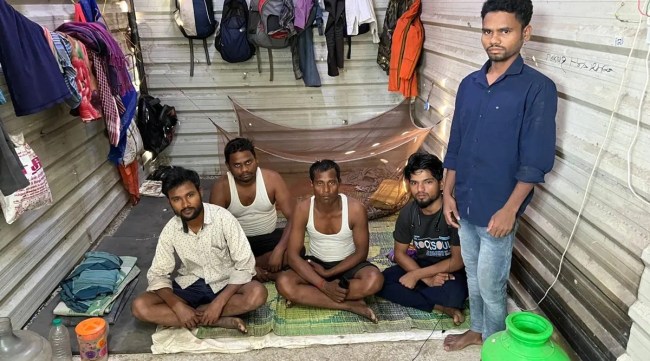Opinion Migrant furore in Tamil Nadu: Both workers and destination states need each other
State-specific conflicts over migration are not new. But strong economic interests have ensured that these do not become serious threats
 Workers from Bihar and Jharkhand at a construction site near Guindy, Chennai. (Express photo by Arun Janardhanan)
Workers from Bihar and Jharkhand at a construction site near Guindy, Chennai. (Express photo by Arun Janardhanan) The images of lakhs of people walking with their meagre belongings on the highways or travelling in overcrowded public transport during the Covid lockdowns underlined the plight of migrant workers across the country. The issue of migrants has once again hit the headlines over reported social media posts of doubtful veracity that Bihari or Hindi-speaking migrants were being ill-treated, leading to a section returning from Tamil Nadu. This coincides with the normal home visit of migrants for Holi and has created apprehensions of an exodus and panic among industry and business houses of their workers not returning immediately.
The absence of census data for 2021 – it is nowhere in sight — unfortunately limits any rigorous discussions on migration. What is available is the recent National Sample Survey data for 2020-21 that provides a snapshot of migration in the backdrop of the Covid pandemic. One of the summary indicators of migration derived from the survey is the percentage of migrants in the population or what is called the migration rate. Overall 28.9 per cent of the population consisted of migrants. In 2007-8 this was 28.5 per cent, almost the same level as now. The two surveys using identical definitions show no major change in the share of migrants in different population groups. While the number of migrants would have gone up, their shares in the population remain stable, negating claims of any spurt in migration in recent years.
Interestingly, among the large states, migration rates have increased significantly in southern India over those in 2007-08 while it has declined in most north Indian states. Studies based on field data also suggest that most of the migrants have returned to their destinations with the withdrawal of travel restrictions over the past few months. One can notice that differences in employment opportunities and earnings overwhelm and overcome the factors behind short-term crises, reinforcing the increase in north-south mobility, backed up by demographic factors like changes in fertility rate and age composition.
Significant improvements in education and health in the country have brought down the total fertility rate to 2.0, below the replacement level where one generation is replaced by another with the same number, stabilising the population in the long run. States like Bihar, Jharkhand and Uttar Pradesh have very high fertility along with a couple of north-eastern states while all southern states have achieved replacement level fertility. In fact, the figures for Kerala and Tamil Nadu are much below the national average. A look at the age structure of the population also provides possible directions for migration across the states. The southern states have an ageing population. People above the age of 6o years are as high as 16 per cent in Kerala, followed by Tamil Nadu, and Andhra Pradesh. These are much lower in Bihar (7.7 per cent), Jharkhand, UP and Madhya Pradesh. Given this demographic advantage of the northern states, southern states with better employment opportunities would continue to attract migrants. One can, therefore, argue that long-term trends in population mobility would be determined by these, although health and politics-related factors would bring in short-term disturbances.
The state-specific conflicts over migration are not new. Several state governments, in the aftermath of Covid, had passed ordinances or attempted to bring legislation to restrict entry of labour from other states. Happily, economic rationality took precedence over political rhetoric. The overall migration rate remains stable and the state-wise migration rates, as discussed above reinforce this point. It is noteworthy that similar or more serious incidents took place against north-eastern workers in Bangalore and elsewhere in Karnataka forcing them to return. But this was fortunately temporary.
Vigorous attempts by the BJP to make inroads and strengthen their base in southern states are understandably coming in conflict with the interests of regional parties that have been raising issues of erosion of local culture, values, history and linguistic imperialism. Anti-Hindi sentiments can in certain situations manifest in posturing or incidents against Hindi-speaking migrants. However, the strong economic interests of the industrialist and business houses have ensured that these do not become serious threats and remain largely as rhetoric.
The assurances given by responsible functionaries to inter-state workers about their safety and freedom to work are very important. But, one cannot dismiss the possibility of these workers being subjected to abuse on one pretext or the other, given the social-media-led politics of the day. However, the model of development has to be inclusive so that India “realises the Asian century”.
Kundu is Senior Fellow of the World Resources Institute and Mohanan is former head of the National Statistical Commission






